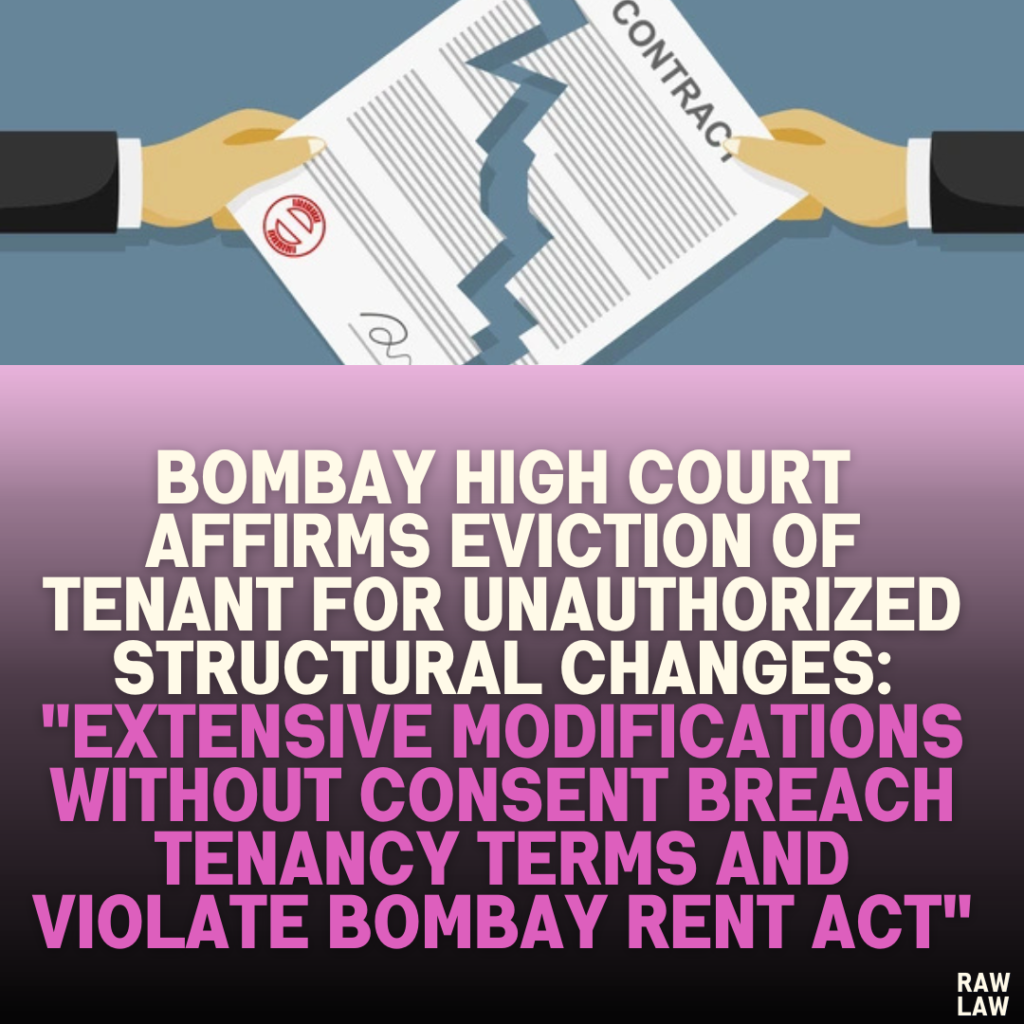Court’s Decision:
The Bombay High Court dismissed the tenant’s writ petition, upholding eviction decrees passed by the trial and appellate courts. The court found that the tenant carried out extensive unauthorized structural renovations to the rented premises without written consent, violating the Bombay Rent Act. These changes were classified as permanent construction under Section 13(1)(b) and as actions causing damage under Section 13(1)(a) of the Act.
The tenant was granted time until February 28, 2025, to vacate the premises on the condition that no third-party rights were created.
Facts:
- Background: The premises consisted of a shop and a back room leased to the tenant for running a hair-cutting salon. The landlord alleged that the tenant made unauthorized alterations in 1990 during the landlord’s absence.
- Allegations:
- Construction of a bathroom with plumbing and fixtures.
- Installation of a loft above the bathroom, supporting a 200-gallon water tank.
- Replacement of the shop’s wooden entrance doors with rolling shutters.
- Replacement of tiles throughout the premises and structural changes to the shop steps.
- Installation of a signboard with steel framing, among other changes.
- Tenant’s Defense:
- The tenant claimed written consent dated January 2, 1986, from the previous landlord for the renovations.
- Asserted that the changes were minor and necessary for better use of the premises, not amounting to “permanent construction.”
Issues:
- Was the tenant’s claim of obtaining prior written consent for the modifications valid?
- Did the alterations constitute “permanent construction” under Section 13(1)(b) of the Bombay Rent Act?
- Did the changes cause injury or damage to the premises under Section 13(1)(a) of the Bombay Rent Act?
Petitioner’s Arguments (Tenant):
- The alterations were carried out with prior written consent from the predecessor landlord, evidenced by a letter dated January 2, 1986.
- The modifications, such as a bathroom and kitchen platform, were minor improvements necessary for better utilization of the property.
- These changes did not alter the structural integrity of the building and should not attract eviction.
Respondent’s Arguments (Landlord):
- The tenant’s alleged consent was fabricated and introduced belatedly through an amended written statement in 1994, after initially denying any alterations.
- The extensive structural changes, such as embedding walls, plumbing modifications, and heavy installations, were carried out without any consent and during the landlord’s absence.
- These unauthorized activities caused significant damage and substantially altered the nature of the premises.
Analysis of the Law:
- Consent Invalidity:
- The court scrutinized the tenant’s claim of prior written consent, finding that:
- It was introduced four years after the lawsuit began.
- Architectural surveys from April 1986 and letters from the previous owners made no mention of the modifications.
- The Appellate Court rightly concluded the consent document was fabricated as an afterthought.
- The court scrutinized the tenant’s claim of prior written consent, finding that:
- Permanent Construction:
- The alterations, such as constructing a bathroom, installing a loft and water tank, and replacing structural fixtures, were deemed substantial and permanent.
- The Bombay Rent Act permits minor renovations but prohibits “permanent construction” without written consent.
- Legislative amendments in 1987 excluded kitchen platforms and tile replacements from the definition of permanent construction. However, the tenant’s extensive renovations went far beyond these exceptions.
- Structural Damage:
- The tenant embedded pipes into load-bearing walls, added heavy structures like a 200-gallon tank, and demolished foundational components.
- These actions caused damage to the structural integrity of the premises, meeting the criteria for eviction under Section 13(1)(a).
- Court’s Findings on Tenant’s Conduct:
- The tenant’s shifting defenses and procedural irregularities (amending pleadings to include fabricated consent) undermined his credibility.
- His renovations, conducted during the landlord’s absence, evidenced a disregard for tenancy terms.
Precedent Analysis:
The court referred to previous judgments on the nature of permanent construction, emphasizing:
- Minor repairs for better use are permissible (e.g., kitchen platforms, privacy screens).
- Extensive alterations altering structural integrity constitute permanent construction and attract eviction.
Cases distinguished:
- Alisaheb Abdul Latif Mulla: Construction of a simple privacy screen was permissible. The tenant here exceeded this by constructing a bathroom, loft, and tank.
- Somnath Krishnaji Gangal: Large-scale renovations, like roof replacements or bathroom installations in commercial premises, were deemed permanent construction. This aligned with the tenant’s actions.
Court’s Reasoning:
- Tenant’s Lack of Credibility:
- Failure to mention the alleged consent initially and its belated introduction suggested bad faith.
- Evidence from architectural surveys and owner correspondence directly contradicted the tenant’s claims.
- Nature of Alterations:
- Construction of a bathroom and loft, embedding walls, and plumbing concealed within walls were not easily reversible and significantly altered the premises.
- The addition of a water tank and other heavy modifications increased structural load, posing safety concerns.
- Legal Obligation:
- Tenants cannot unilaterally overhaul premises without landlord consent while enjoying rent protections. The alterations breached the tenancy agreement.
Conclusion:
The High Court upheld the concurrent findings of the trial and appellate courts:
- The alterations amounted to permanent construction and caused damage to the premises.
- The tenant’s defenses were contradictory and lacked merit.
Outcome:
- The writ petition was dismissed.
- The tenant was given time until February 28, 2025, to vacate the premises, with strict conditions against creating third-party rights.
Implications:
This judgment underscores the limits of tenant rights under the Bombay Rent Act, emphasizing that structural changes without explicit landlord consent can attract eviction. It reinforces landlords’ protections against unauthorized renovations and highlights the importance of adhering to tenancy terms.
